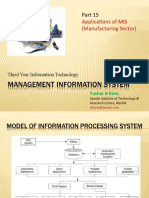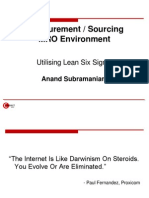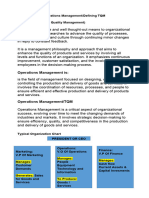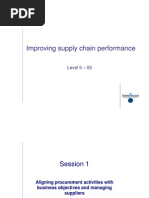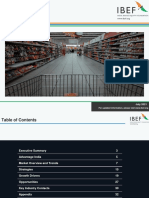0 ratings0% found this document useful (0 votes)
20 viewsModule 4 Functional Subsystems
The document describes several functional subsystems within an organization including finance and accounting, sales and marketing, manufacturing, logistics and material management, personnel management, R&D management. For each subsystem, it outlines the main goal, key transactions, and operational, tactical and strategic level of control.
Uploaded by
nCopyright
© © All Rights Reserved
Available Formats
Download as PDF, TXT or read online on Scribd
0 ratings0% found this document useful (0 votes)
20 viewsModule 4 Functional Subsystems
The document describes several functional subsystems within an organization including finance and accounting, sales and marketing, manufacturing, logistics and material management, personnel management, R&D management. For each subsystem, it outlines the main goal, key transactions, and operational, tactical and strategic level of control.
Uploaded by
nCopyright
© © All Rights Reserved
Available Formats
Download as PDF, TXT or read online on Scribd
You are on page 1/ 31
Functional Subsystems
FINANCE & ACCOUNTING
Main Goal:
Finance- Ensure financial viability of the
organization, enforce financial discipline ,
plan & monitor financial budgets (credit to
customers, cash management, financing
arrangements (loans, sales of stocks,
leasing), collection process).
Accounting- Classification of financial
transactions & standardization into std.
financial reports (income statement and
balance sheet), preparation of budgets,
classification and analysis of cost data.
FINANCE & ACCOUNTING:
Transactions
Credit Applications
Sales Billing
Documentary Collection
Payment vouchers
Cheques
Journal vouchers
Stock transfers
Accounts Receivable records
Accounts Payable records
Payroll records
Inventory control records
Ledgers
FINANCE & ACCOUNTING: Operational
control
Periodic financial reports
Budget status to all financial managers
Tax returns
Share transfers
Profit & loss accounts
Payment & receipts analysis
Payroll, PF accounts
Calculation of direct costs- Overhead & std. cost
Daily error & exception reporting
Reporting unprocessed transactions and
processing delays
FINANCE & ACCOUNTING: Tactical
control
Variance b/w budget & expenses
Large outstanding payments/receipts
Credit & payment status
Cost increases & pricing
Cost of processing accounting data, error rates.
FINANCE & ACCOUNTING: Strategic
control
Methods of financing
Pricing Policies
Tax planning
Planning of systems for cost accounting &
budgeting
Long range tax accounting policy to
minimize impact of taxes
SALES & MARKETING
Main Goal: Maximize the sales & ensure
customer satisfaction
4 P’s of marketing
◦ Product
◦ Place
◦ Promotion
◦ Price
SALES & MARKETING SUBSYSTEMS:
TRANSACTIONS
Sales Orders
Promotion materials
Feedback forms
SALES & MARKETING SUBSYSTEMS:
OPERATIONAL CONTROL
Sales analysis by regions, customer class &
sales persons
Sales target V/s Achievement
Seasonal variations
Effect of model changes
Performance of sales outlet
Cost of sales, campaigns & benefits.
Hiring & training salesforce.
Day to day schedules
Feedback analysis
SALES & MARKETING SUBSYSTEMS:
TACTICAL CONTROL
Advertising techniques & analysis of their impact
Customer preference surveys
Correlation of prices & sales
Sales force deployment & targets
Exploring alternate market channels
Timing of special sales campaigns
Overall performance against a marketing plan
Data on the customer , competitors, competitor
products & sales force requirements
Market share & trend
Modifications based on feedback
SALES & MARKETING SUBSYSTEMS:
STRATEGIC CONTROL
Search for new markets & marketing
strategies
Analysis of competitors strategy
Technology & demographic forecasts &
product changes
Customer analysis results
Consumer survey
Income Projections
Demographic Projections
Technology Projections
Manufacturing Subsystem
Main Goal: To optionally and optimally deploy human
resources, machines and materials to maximize quality
production of goods by the organization
Functions:
Product engineering
Planning of production facility
Employment and training
Quality Control and Inspection
Needs of New Marketplace:
Lean
Agile
Flexible
Managed for Quality
Manufacturing Subsystem –
Transactions
Production order (based on explosion of sales
orders and inventory requirements)
Assembly orders
Finished parts documents
Scrap items documents
Time keeping documents
Manufacturing Subsystem- Operational
control
Monitoring up to date production information
by examining assemblies, giving early
warning about likely shortages
Scheduling better production dynamically
Preventive maintenance schedules of
machines
Monitoring tools, machine and personnel
availability
Detailed reports of actual performance
against production schedules
Manufacturing Subsystem – Tactical
control
Identifying and controlling areas of high costs
such as WIP inventories
Identifying critical bottlenecks in Production
Identifying alternate production schedules
based on tools, machines, materials and
personnel availability
Performance measures of machines to decide
on replacement
Planned or standard v/s Actual performance
Manufacturing Subsystem –
Strategic control
Yearly production quotes and alternate
schedules
Policies on machine replacement, augmentation
and modernization
Introduction of new production technologies
Identifying best product mix
LOGISTICS & MATERIAL
MANAGEMENT SUBSYSTEMS:
Main Goal:
To have readily available material needed
& to keep optimal levels of stock
Purchasing, receiving, inventory control
& distribution.
LOGISTICS & MATERIAL
MANAGEMENT SUBSYSTEMS:
TRANSACTIONS
Purchase requisitions
Purchase orders
Manufacturing orders
Tickets for inventory
Shipping Orders
LOGISTICS & MATERIAL MANAGEMENT
SUBSYSTEMS: OPERATIONAL CONTROL
List of excess & deficient items required.
List of items rejected
Critical items required
Backlog of supplies
Value of inventory in hand
Goods received, rejected & issues
Past due purchases, shipments to customer
Overstocked items/out of stock items
Inventory turnover reports
Vendor performance summaries
Shipper performance analysis
LOGISTICS & MATERIAL
MANAGEMENT SUBSYSTEMS:
Tactical Control
Developing vendor & shipper performance
measures
Determining the impact on the materials cost,
availability & procurement with design changes &
new product information
Determining optimal reorder levels
Determining issues of items to shops v/s std need
Controlling high value inventory
Comparing planned vs actual
LOGISTICS & MATERIAL
MANAGEMENT SUBSYSTEMS:
Strategic Control
Developing vendor for critical items
Developing optimal levels of inventory
Determining proportion of material to be
reordered from different vendors
Deciding varieties in inventory
Analysis of new policies with regard to
vendors
“Make V/s Buy” strategies
PERSONNEL MANAGEMENT
SUBSYSTEMS
Main Goal: To make use of available
human resources in the org. Includes
hiring, training, record keeping,
payment & termination of personnel
PERSONNEL MANAGEMENT
SUBSYSTEMS: TRANSACTIONS
Documents describing employment
requisitions
Document describing job descriptions
Training requirement specifications
Personnel data documents
Information regarding pay rate changes
Time cards (no of hours worked)
Pay cheques
Documents describing benefits
Termination notices
PERSONNEL MANAGEMENT
SUBSYSTEMS: OPERATIONAL
CONTROL
Routine assessment
Procedure for hiring & termination
Procedure for changing pay rates & issuing
benefits
Leave Records
Loan/advances & recoveries
Skill Inventory
Procedure for training
PERSONNEL MANAGEMENT
SUBSYSTEMS: TACTICAL CONTROL
Performance appraisal
Demographic make-up of personnel & its impact on
retirement
Production incentives & relation to productivity
Morale of personnel
Absentee reduction
Leave & overtime policies
Personnel deployment policies
Analysis from reports of variances resulting from
differences between planned & actual performances
for such classifications as no. of employees hired,
cost of training & recruiting, salary paid,
distribution of wage rate etc.
PERSONNEL MANAGEMENT
SUBSYSTEMS: STRATEGIC CONTROL
Large range human resources requirement
at different levels
Policies on wages & incentives
Policies on HR development & training
Policies on personnel welfare & facilities
Analysis of shifting pattern of employment
& education
R & D Management
Main goal: Continuously improve existing
products and develop new products and
processes
R & D Management -
Transactions
Product Literature
Designs
Implementation plans
Reports
R & D Management –
Operational Control
Progress against goals
Budgeted expenses V/s Actuals
Status of outstanding orders for equipment
and components
R & D Management –
Tactical Control
Setting intermediate goals and assess
progress
Check availability of equipment and
appropriate selection
Determine resource allocation
Deployment of personnel to projects based
on talent and performance
Information on similar and related research
projects undertaken by other groups
R & D Management –
Strategic Control
Which Products?
What type of Improvements?
What Long range research is most promising?
Technical collaboration
New Human resource requirement
You might also like
- Hourglass Workout Program by Luisagiuliet 276% (21)Hourglass Workout Program by Luisagiuliet 251 pages
- The Hold Me Tight Workbook - Dr. Sue Johnson100% (16)The Hold Me Tight Workbook - Dr. Sue Johnson187 pages
- Read People Like A Book by Patrick King-Edited62% (66)Read People Like A Book by Patrick King-Edited12 pages
- Livingood, Blake - Livingood Daily Your 21-Day Guide To Experience Real Health77% (13)Livingood, Blake - Livingood Daily Your 21-Day Guide To Experience Real Health260 pages
- COSMIC CONSCIOUSNESS OF HUMANITY - PROBLEMS OF NEW COSMOGONY (V.P.Kaznacheev,. Л. V. Trofimov.)94% (212)COSMIC CONSCIOUSNESS OF HUMANITY - PROBLEMS OF NEW COSMOGONY (V.P.Kaznacheev,. Л. V. Trofimov.)212 pages
- Donald Trump & Jeffrey Epstein Rape Lawsuit and Affidavits83% (1016)Donald Trump & Jeffrey Epstein Rape Lawsuit and Affidavits13 pages
- The 36 Questions That Lead To Love - The New York Times94% (34)The 36 Questions That Lead To Love - The New York Times3 pages
- The 36 Questions That Lead To Love - The New York Times95% (21)The 36 Questions That Lead To Love - The New York Times3 pages
- Jeffrey Epstein39s Little Black Book Unredacted PDF75% (12)Jeffrey Epstein39s Little Black Book Unredacted PDF95 pages
- The 4 Hour Workweek, Expanded and Updated by Timothy Ferriss - Excerpt23% (954)The 4 Hour Workweek, Expanded and Updated by Timothy Ferriss - Excerpt38 pages
- Data Warehousing and Multi-Dimensional Data ModellingNo ratings yetData Warehousing and Multi-Dimensional Data Modelling15 pages
- Application of MIS in Manufacturing Sector77% (13)Application of MIS in Manufacturing Sector24 pages
- Employee Job Description in Manufacturing Industry100% (1)Employee Job Description in Manufacturing Industry5 pages
- Application of Mis in Manufacturing SectorNo ratings yetApplication of Mis in Manufacturing Sector66 pages
- Internal Routine Reporting and Decisions Internal Non-Routine Reporting and Decisions External ReportingNo ratings yetInternal Routine Reporting and Decisions Internal Non-Routine Reporting and Decisions External Reporting22 pages
- Application of MIS in Manufacturing SectorNo ratings yetApplication of MIS in Manufacturing Sector15 pages
- Introduction To Managerial Accounting ACC 200No ratings yetIntroduction To Managerial Accounting ACC 20022 pages
- Lecture 4 - of + MFM + Mass Customization at Hewlett Packard - The Power of PostponementNo ratings yetLecture 4 - of + MFM + Mass Customization at Hewlett Packard - The Power of Postponement20 pages
- Director Purchasing Procurement Manager in Oklahoma City OK Resume Jeff AmendNo ratings yetDirector Purchasing Procurement Manager in Oklahoma City OK Resume Jeff Amend3 pages
- Eprocurement / Sourcing Mro Environment: Utilising Lean Six SigmaNo ratings yetEprocurement / Sourcing Mro Environment: Utilising Lean Six Sigma33 pages
- Sales and Marketing: System Description Organisational LevelNo ratings yetSales and Marketing: System Description Organisational Level6 pages
- Director Materials Supply Chain in CA Resume Sue ThorntonNo ratings yetDirector Materials Supply Chain in CA Resume Sue Thornton3 pages
- Ch04 - COMMON - BUSINESS - APPLICATIONSOF INFORMATIONNo ratings yetCh04 - COMMON - BUSINESS - APPLICATIONSOF INFORMATION60 pages
- Introduction to Inventory and Quality Control_20240329_153458_0000No ratings yetIntroduction to Inventory and Quality Control_20240329_153458_000027 pages
- Module 1-Functional Information SystemsNo ratings yetModule 1-Functional Information Systems30 pages
- MIS Structure Based On Organization Function: Made By: Ajat Shatru Sharma Sakshi AroraNo ratings yetMIS Structure Based On Organization Function: Made By: Ajat Shatru Sharma Sakshi Arora13 pages
- Q1: SAP ERP (Enterprise Resource Planning) Is Commercial Software That WillNo ratings yetQ1: SAP ERP (Enterprise Resource Planning) Is Commercial Software That Will8 pages
- Application of Decision Sciences To Solve Business Problems: CPG IndustryNo ratings yetApplication of Decision Sciences To Solve Business Problems: CPG Industry20 pages
- Operations Management and TQM Module 2 3No ratings yetOperations Management and TQM Module 2 375 pages
- Credit Rating Information Services Equity ResearchNo ratings yetCredit Rating Information Services Equity Research6 pages
- ISPE - Indo - Process & Product Review & CINo ratings yetISPE - Indo - Process & Product Review & CI70 pages
- ERP Sales & Mark by Poorva Sagar MahuriNo ratings yetERP Sales & Mark by Poorva Sagar Mahuri18 pages
- L5 03 Improving Supply Chain Performance Integrative UnitNo ratings yetL5 03 Improving Supply Chain Performance Integrative Unit156 pages
- Cost Management Amp Strategic Decision Making100% (1)Cost Management Amp Strategic Decision Making124 pages
- Lap. Harian GGL 6 SUTET 275 KV (25 Oktober 2023)No ratings yetLap. Harian GGL 6 SUTET 275 KV (25 Oktober 2023)2 pages
- Porter's Five Forces - The Framework Explained - A Guide To Analyzing Competitiveness Using Michael Porter's Strategic ModelNo ratings yetPorter's Five Forces - The Framework Explained - A Guide To Analyzing Competitiveness Using Michael Porter's Strategic Model16 pages
- Poter's Five Forces Analysis - Group No 02No ratings yetPoter's Five Forces Analysis - Group No 028 pages
- Modul-Document Control Training - Agus F - 12 Juli 2023 Rev1100% (1)Modul-Document Control Training - Agus F - 12 Juli 2023 Rev134 pages
- Additional Exercises For Mid Term Test 1No ratings yetAdditional Exercises For Mid Term Test 142 pages
- A Roadmap To World Class Forecasting AccuracyNo ratings yetA Roadmap To World Class Forecasting Accuracy53 pages
- Facebook Ads Optimization: 1. Defining Clear ObjectivesNo ratings yetFacebook Ads Optimization: 1. Defining Clear Objectives6 pages
- Micro Chapter 18 Practice Problems 2 KeyNo ratings yetMicro Chapter 18 Practice Problems 2 Key4 pages
- Role of Information Systems in Business Today: Globalization Challenges and OpportunitiesNo ratings yetRole of Information Systems in Business Today: Globalization Challenges and Opportunities14 pages
- Warehouse Management System: Complex Processes - Easily OperatedNo ratings yetWarehouse Management System: Complex Processes - Easily Operated12 pages
- Livingood, Blake - Livingood Daily Your 21-Day Guide To Experience Real HealthLivingood, Blake - Livingood Daily Your 21-Day Guide To Experience Real Health
- COSMIC CONSCIOUSNESS OF HUMANITY - PROBLEMS OF NEW COSMOGONY (V.P.Kaznacheev,. Л. V. Trofimov.)COSMIC CONSCIOUSNESS OF HUMANITY - PROBLEMS OF NEW COSMOGONY (V.P.Kaznacheev,. Л. V. Trofimov.)
- Donald Trump & Jeffrey Epstein Rape Lawsuit and AffidavitsDonald Trump & Jeffrey Epstein Rape Lawsuit and Affidavits
- The 36 Questions That Lead To Love - The New York TimesThe 36 Questions That Lead To Love - The New York Times
- The 36 Questions That Lead To Love - The New York TimesThe 36 Questions That Lead To Love - The New York Times
- Jeffrey Epstein39s Little Black Book Unredacted PDFJeffrey Epstein39s Little Black Book Unredacted PDF
- The 4 Hour Workweek, Expanded and Updated by Timothy Ferriss - ExcerptThe 4 Hour Workweek, Expanded and Updated by Timothy Ferriss - Excerpt
- Data Warehousing and Multi-Dimensional Data ModellingData Warehousing and Multi-Dimensional Data Modelling
- Employee Job Description in Manufacturing IndustryEmployee Job Description in Manufacturing Industry
- Internal Routine Reporting and Decisions Internal Non-Routine Reporting and Decisions External ReportingInternal Routine Reporting and Decisions Internal Non-Routine Reporting and Decisions External Reporting
- Lecture 4 - of + MFM + Mass Customization at Hewlett Packard - The Power of PostponementLecture 4 - of + MFM + Mass Customization at Hewlett Packard - The Power of Postponement
- Director Purchasing Procurement Manager in Oklahoma City OK Resume Jeff AmendDirector Purchasing Procurement Manager in Oklahoma City OK Resume Jeff Amend
- Eprocurement / Sourcing Mro Environment: Utilising Lean Six SigmaEprocurement / Sourcing Mro Environment: Utilising Lean Six Sigma
- Sales and Marketing: System Description Organisational LevelSales and Marketing: System Description Organisational Level
- Director Materials Supply Chain in CA Resume Sue ThorntonDirector Materials Supply Chain in CA Resume Sue Thornton
- Ch04 - COMMON - BUSINESS - APPLICATIONSOF INFORMATIONCh04 - COMMON - BUSINESS - APPLICATIONSOF INFORMATION
- Accounting 2: QuickStudy Laminated Reference GuideFrom EverandAccounting 2: QuickStudy Laminated Reference Guide
- Introduction to Inventory and Quality Control_20240329_153458_0000Introduction to Inventory and Quality Control_20240329_153458_0000
- MIS Structure Based On Organization Function: Made By: Ajat Shatru Sharma Sakshi AroraMIS Structure Based On Organization Function: Made By: Ajat Shatru Sharma Sakshi Arora
- Q1: SAP ERP (Enterprise Resource Planning) Is Commercial Software That WillQ1: SAP ERP (Enterprise Resource Planning) Is Commercial Software That Will
- Application of Decision Sciences To Solve Business Problems: CPG IndustryApplication of Decision Sciences To Solve Business Problems: CPG Industry
- Credit Rating Information Services Equity ResearchCredit Rating Information Services Equity Research
- L5 03 Improving Supply Chain Performance Integrative UnitL5 03 Improving Supply Chain Performance Integrative Unit
- Controllership: The Work of the Managerial AccountantFrom EverandControllership: The Work of the Managerial Accountant
- Porter's Five Forces - The Framework Explained - A Guide To Analyzing Competitiveness Using Michael Porter's Strategic ModelPorter's Five Forces - The Framework Explained - A Guide To Analyzing Competitiveness Using Michael Porter's Strategic Model
- Modul-Document Control Training - Agus F - 12 Juli 2023 Rev1Modul-Document Control Training - Agus F - 12 Juli 2023 Rev1
- Facebook Ads Optimization: 1. Defining Clear ObjectivesFacebook Ads Optimization: 1. Defining Clear Objectives
- Role of Information Systems in Business Today: Globalization Challenges and OpportunitiesRole of Information Systems in Business Today: Globalization Challenges and Opportunities
- Warehouse Management System: Complex Processes - Easily OperatedWarehouse Management System: Complex Processes - Easily Operated





































